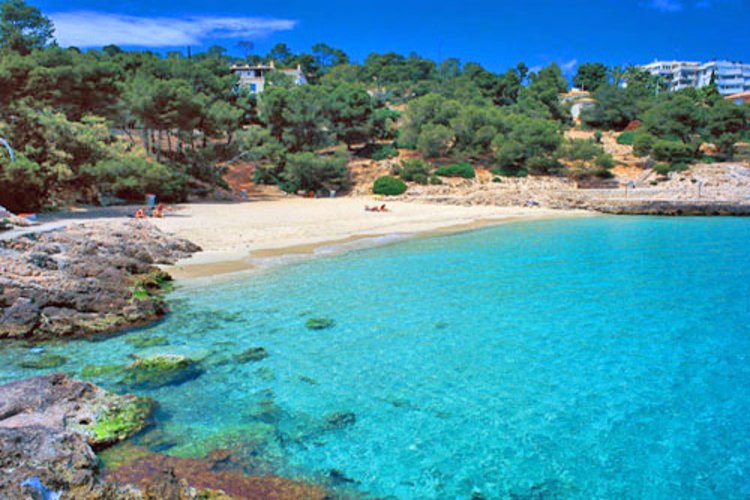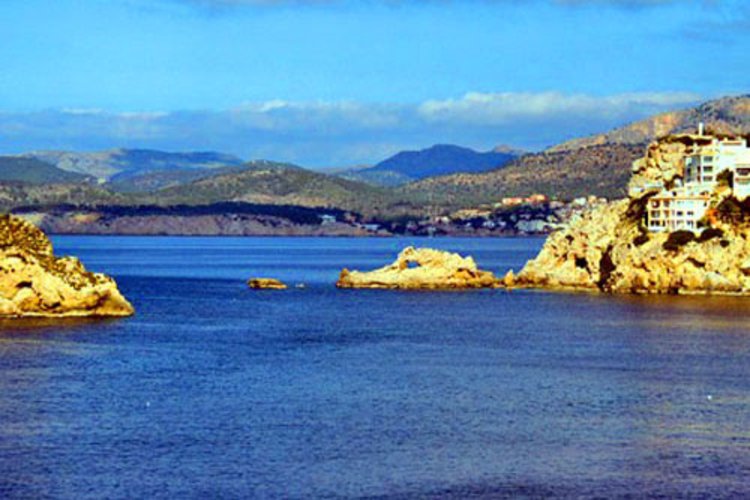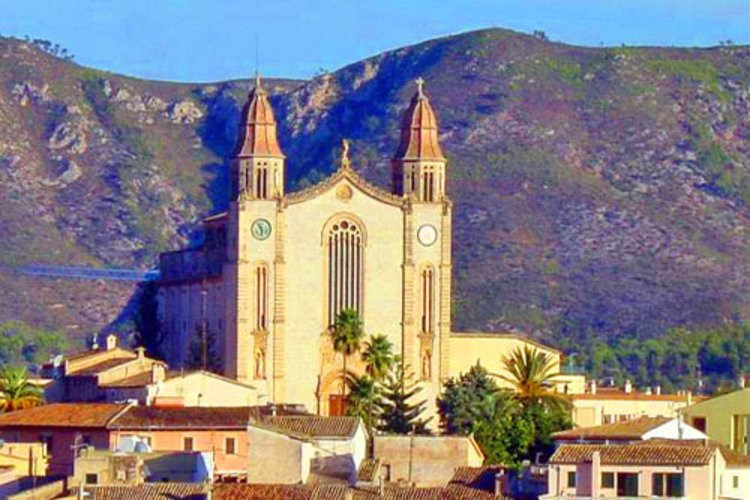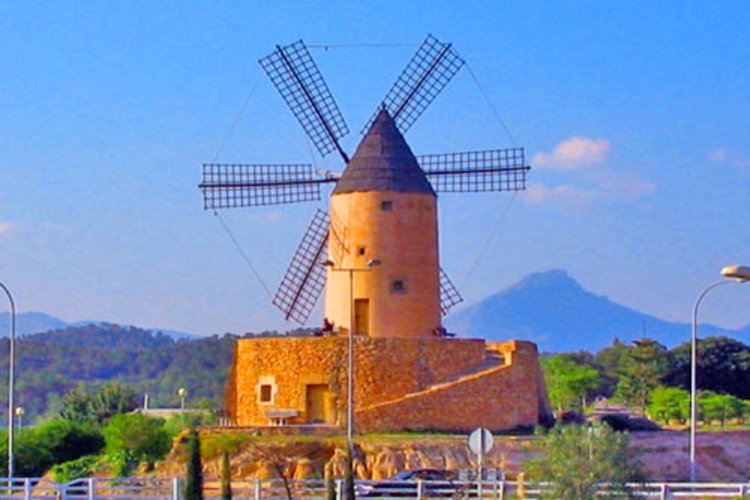Calviá
Calvia itself is only a small town of 9000 inhabitants and lies off the coast between Palma and Andratx, but the management area extends over the entire coastal region up to Cala Fornells.

Calvià is a large community of cities on the Spanish Balearic island of Mallorca. Calvià The community is located in the west of the island of Majorca, in the region of the Pariatge and is only 20 minutes from the airport of the island. Motorway towards Palma Andratx, at the junction of Palma Nova on the main road onto MA-1015. It is bordered to the north and Estellencs Puigpunyent, in the east of Palma, Andratx, in the west and south to the Mediterranean Sea. A number of places and urbanizations belong to the municipality Calvià. They use the same seal of quality and have the same identity, although each of these places have characteristics which had characterized him: Cas Català - Illetes, Bendinat - Portals Nous, Magaluf, Palmanova, Santa Ponsa, Peguera, Calvià Vila and it Capdella. Its unique geographic position allows her over a 54 km long coastal strip and simultaneously on a vast forest area in the interior. Moreover Calvià enjoys the privilege of 300 sunny days a year to have. The area around Calvià against the northern winds by the Tramuntana mountains and numerous woods, which surrounded the area and throughout the year versed can be protected. The municipality covers an area of 14,275 hectares. The coasts are rocky and grow in their different native plant species, such as Devora Alzinaris or pine trees. In particular, the Banc d'Eivissa and Illot del Toro, which is a special Eidechsenart finds that it is only in the Balearic Islands there. Statistics Calvià The municipality has an area of 144.97 kilometers ² and 47,934 inhabitants (as of 2007) compared with 28,748 inhabitants (1996). This represents a population density of 330.6 persons per km ². Thus, Calvià Manacor overhauled and is now the second largest town of the island. In 2006 the proportion of foreigners 29.4% (13,312), the proportion of German population of 6.7% (3,031). Belong to this community for over ten mountains, with the Puig de Galatzo 1027 m with the highest and the Puig d'en Zaragoza by 187 m of the lowest. 1991, or 43.87% of the population Majorcans, 44.42% came from other Spanish provinces and 11,45% were foreigners. Until 1960 this community had just 3,000 inhabitants. From this time onwards the population increased slowly at first but since the 1970s to steep. Places in the community To Calvià include the following locations: • Badia de Palma (685 / 685 inhabitants) • Calvià (2041 / 2311 inhabitants) • Cas Català - Ses Illetes (3436 / 3436 inhabitants) • Castell de Bendinat (511 / 511 inhabitants) • Costa d'en Blanes (1995 / 1995 inhabitants) • Costa de sa Calma (1546 / 1546 inhabitants) • El Toro (2221 / 2221 inhabitants) • It Capdella (887 / 962 inhabitants) • Galatzo (1548 / 1574 inhabitants) • Magaluf (3976 / 3981 inhabitants) • Palmanova (6487 / 6503 inhabitants) • Peguera (3762 / 3762 inhabitants) • Portals Nous (2512 / 2512 inhabitants) • Portals Vells (36 / 36 people) • Santa Ponsa (9776 / 9776 inhabitants) • Sat Porrassa (121 / 121 inhabitants) • Sol de Mallorca (512 / 512 inhabitants) • Son Ferrer (5489 / 5490 inhabitants) The population figures in brackets come from 1 January 2007. The first number indicates the population of urban areas, the second number of the inhabitants of places, including the addition to calculating scattered population living outside the main settlements. (Source: INE) Education A portion of the population had (1996) no schooling (128 inhabitants), most residents had a folk school (ETUC, 8 years) (6631 inhabitants), or the Mittlere Reife (BUP, 12 years) (4641 persons) and only (775 persons ) had a university degree. History The origin of the name Calvià is not clearly understood. Some evidence suggests that the name comes from the Latin "caluus Calbe" comes because it is a very dry area, which little vegetation. Another theory suggests that the name derives from the Roman, although the exact origin is uncertain. In the 12th Calvià century was to a community with the original name of the Holy Ihoannes Caviano. Since the Saint John was revered here, is put on the coat of arms of the municipality before the Lamb. The latter is only a presumption. The community Calvià, together with Palma, the top two priorities for the 1229 conquest of Mallorca by King Jaume I., before Santa Ponsa went ashore. In commemoration of this event was a cross erected on the site where the first time the monarch has touched the ground. Prehistoric Time The first traces of human civilization in Calvià lead in the year 2000 BC. They were mostly ranchers, the most important cultural origins of the Balearic Islands, is further developed: the Talayotic culture, which, by the various merchants of the Mediterranean peoples greatly influenced. Time of the Romans From this period, from 123 BC until the end of the 5th Century, it is especially the Roman city of Sa Mesquida stress because it is one of the few Roman finds on Majorca. Middle Ages The culture, the very clear traces of Majorca has left is the Arab culture. The community Calvià was part of the administrative area of Juz'd'Ahwaz al-Madina. Since the year 903 was the first of Mallorca Almoravids and later conquered by the Almohads, and hence the island was part of the Taif-kingdom. But it was Jaume I and his conquest of the strongest influence on the Majorcan culture had. This Catalan-Aragonese king landed on 10 September 1229 in Santa Ponsa and transferred according to official publications, such as the "del llibre Repartiment", the Bishop of Barcelona Berenguer de Palou, possession of Calvià and all neighboring communities. This zone was therefore in possession of the kingdom and the church, and this situation caused some tension between them. The problem was later replaced by the formula of "Pariatge" resolved. During this period, and the cities grew and Calvià Capdella. The city was Calvià as such in the year 1285, during the reign of Jaume II, son of Jaume I., was founded. Jaume I. brought the Christian faith back to Mallorca. Since the Middle Ages the island from many North African pirates hit was the construction of a defense system necessary to the establishment of numerous towers based. The modern era In the 16th Calvià century was finally liberated by the bubonic plague, which at this time for the deaths of many people was responsible. Beginning of the eighteenth century there were in this zone, a persistent drought and a harsh famine. In 1715 was Mallorca by King Philip V governed by the Decree (Nova Planta), and with the help of the upper layers of the Kastellanisierung drove ahead of the island. Contemporary era Driven by hunger and chronic poverty, many residents had Calviàs in the nineteenth century to Algeria, Cuba, Argentina or France emigrate. The labor movement has in political life Calviàs always played an important role. Evidence of this is the foundation of the labor movement Calviàs in 1923, which belonged to the workers union. Later, two other organizations: Agriculture Calviàs union and fraternal union. The political events during the Second Republic is characterized by the socialist thinking. This influence should persist for many years. The boom in tourism With the appearance of tourism at the beginning of the sixties, brought agriculture into the background, and Calvià became one of the leading communities in this area. The community grew up dynamically with the help of European investment. The growth of tourism but also a rapid development of the construction and services sector with them. This has a positive impact on the creation of numerous jobs and the influx of migrants from the mainland from the inside. Archaeological finds The archaeological finds of the community Calviàs are among the most numerous and best cataloged on the island. Calvià has one of the most valuable archaeological relics, both in the nature of the finds, as well as in the quality of the excavated material. Thanks to these findings, a large part of the history of Santa Ponsas understand. This enabled the establishment of an archaeologically protected area set in motion and the early creation of an archaeological park: The park of Puig de sa Morisca.















